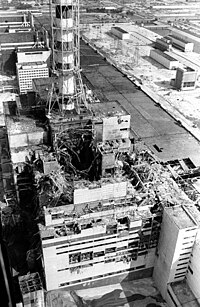
Photo from wikipedia
As in other nuclear countries, the operation of the Ignalina nuclear power plant in Lithuania has led to the accumulation of around 22 thousand assemblies of spent nuclear fuel (SNF).… Click to show full abstract
As in other nuclear countries, the operation of the Ignalina nuclear power plant in Lithuania has led to the accumulation of around 22 thousand assemblies of spent nuclear fuel (SNF). The development of geological disposal program involves an iterative assessment of the system safety supported by scientific research on radionuclides migration and related processes. This study focused on the application of Contribution to the Sample Mean (CSM) and Contribution to Sample Variance (CSV) methods to complement the uncertainty and sensitivity analyses of the time-dependent flux of I-129 from the engineered barriers of a conceptual disposal facility for RBMK-1500 SNF (RBMK is abbreviation of “High Power Channel-type Reactor” (in Russian)). The analysis was performed using a MATLAB platform (8.0.0.783 (R2012b), MathWorks, MA, USA). The mean and variance ratios derived from CSM and CSV plots were applied to estimate the effect of reduced uncertainty range on mean flux and its variance, and the uncertainty analysis was also complimented. Increasing the lower bounding value of defect size enlargement time range to 4.6 × 104 years would lead to a lower mean flux until 5 × 104 years after repository closure. Later on (up to 1 million years after repository closure), the only reduction of the upper bounding value of the SNF dissolution rate range would affect a decreased mean flux.
Journal Title: Minerals
Year Published: 2019
Link to full text (if available)
Share on Social Media: Sign Up to like & get
recommendations!